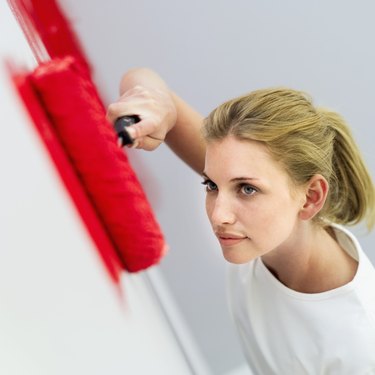
Color-washing, rag rolling and dry-brushing are techniques that give your walls a Tuscan finish when you apply them over rough plaster to heavily textured drywall. The sun-drenched, rich hues of the Mediterranean style warms interiors, and the chalky, antiqued whites take your decor back in time. To find the precise color that will illuminate your walls, experiment on a spare piece of drywall or large cardboard panel. Then observe the color in varied lights to see how it will play on the walls.
Rough It Up
Video of the Day
You can totally faux a Tuscan look on the walls with nothing more than your paintbrush -- but roughing up the wall texture first will take it to another level. As a method that is not very complicated to pull off, it is messy. Lay a dropcloth, or three or four, on the floor and over any furniture that's still in the room. Tape the edges of areas to be plastered with painter's tape to protect ceiling, trim and baseboards. Apply light joint compound, thinned slightly with water if necessary, with a flat putty knife. Layer it on the wall in swirls and random streaks, avoiding any thick buildup but leaving the finish a bit rough. Once it dries, sand lightly and then prime the wall over the raw plaster. A mix of half primer and half base coat begins the process of color layering on the wall.
Video of the Day
The Light in Your Palazzi
Color is everything in a Tuscan finish. Paint hues tend to have some warming yellow or orange in them but nature, neutral and jewel tones all have their place too. A rustic look incorporates pink, mustard, terra cotta, mushroom and leaf colors. Classic Tuscan interiors frequently default to whites -- always a warm white -- and those may be smudged and faux-aged with dry-brushed grays or diluted brown glazes. A palatial Tuscan villa indulges in more vivid hues. Rich, deep colors and jewel-like shades -- emeralds, rubies, sapphires, topaz and amethyst are arresting in living and dining rooms, entry hallways and powder rooms.
Paint a Panino on the Wall
A Tuscan paint finish is like a sandwich, an Italian panino of appetizing layers that merge to create a distinctive flavor. Once your base coat dries on the rough-plastered wall, apply a second coat of paint, barely diluted with water so it washes over the wall with some translucence. The base color, if different, will show through in places. Use color-washing techniques -- paint strokes every-which-way re-worked with the brush when they begin to drip. A clean rag smooths and blurs the wet paint while absorbing any big drips. Don't wipe up too much paint or eliminate all brush marks. Leave concentrations of paint in the plaster crevices for more texture. The third coat is a delicate dry-brushing with a lighter or darker contrast. This layer of paint will catch all the ridges and raised plaster swirls -- don't press hard on the brush and don't get much paint on the wall. The dry-brushed coat creates only highlights.
Upscale Tuscan
Deeper wall colors replicate the opulent architecture in Tuscan cities such as Florence, where stucco and plaster are burnished, trimmed in gold and reflect the rich furnishings and art in the decor. Vine-green gleams like emerald in a library lined with bespoke wood shelves and filled with Italian antiques. Edge vine-green crown molding with the same tarnished gold as picture frames -- once the plaster walls are color-washed. Flat pimiento-red or warm pumpkin in the living room or kitchen work with both copper pans and honey-colored wood trim. The drama of a sapphire entry is balanced by floors set with Tuscan limestone tiles.